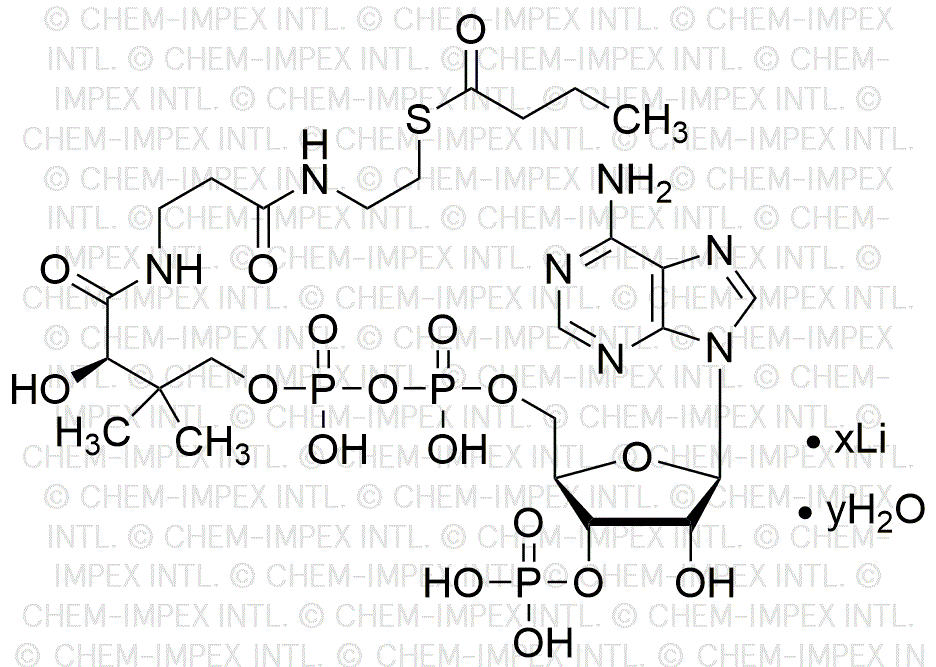Butyryl coenzyme A lithium salt hydrate is widely utilized in research focused on:
- Biochemical Research: This compound serves as a crucial substrate in enzymatic reactions, particularly in studies involving fatty acid metabolism and energy production, helping researchers understand metabolic pathways.
- Pharmaceutical Development: It is used in the synthesis of various pharmaceuticals, especially those targeting metabolic disorders, providing a foundation for drug design and development.
- Cell Culture Applications: The compound is beneficial in cell culture systems, enhancing the growth and differentiation of specific cell types, which is essential for regenerative medicine and tissue engineering.
- Analytical Chemistry: It acts as a standard in analytical methods, aiding in the quantification of related metabolites in biological samples, thus improving the accuracy of biochemical assays.
- Metabolomics Studies: This chemical plays a role in metabolomics, allowing researchers to profile metabolic changes in response to various treatments, which can lead to insights in disease mechanisms and therapeutic strategies.
General Information
Properties
Safety and Regulations
Applications
Butyryl coenzyme A lithium salt hydrate is widely utilized in research focused on:
- Biochemical Research: This compound serves as a crucial substrate in enzymatic reactions, particularly in studies involving fatty acid metabolism and energy production, helping researchers understand metabolic pathways.
- Pharmaceutical Development: It is used in the synthesis of various pharmaceuticals, especially those targeting metabolic disorders, providing a foundation for drug design and development.
- Cell Culture Applications: The compound is beneficial in cell culture systems, enhancing the growth and differentiation of specific cell types, which is essential for regenerative medicine and tissue engineering.
- Analytical Chemistry: It acts as a standard in analytical methods, aiding in the quantification of related metabolites in biological samples, thus improving the accuracy of biochemical assays.
- Metabolomics Studies: This chemical plays a role in metabolomics, allowing researchers to profile metabolic changes in response to various treatments, which can lead to insights in disease mechanisms and therapeutic strategies.
Documents
Safety Data Sheets (SDS)
The SDS provides comprehensive safety information on handling, storage, and disposal of the product.
Product Specification (PS)
The PS provides a comprehensive breakdown of the product’s properties, including chemical composition, physical state, purity, and storage requirements. It also details acceptable quality ranges and the product's intended applications.
Certificates of Analysis (COA)
Search for Certificates of Analysis (COA) by entering the products Lot Number. Lot and Batch Numbers can be found on a product’s label following the words ‘Lot’ or ‘Batch’.
*Catalog Number
*Lot Number
Certificates Of Origin (COO)
This COO confirms the country where the product was manufactured, and also details the materials and components used in it and whether it is derived from natural, synthetic, or other specific sources. This certificate may be required for customs, trade, and regulatory compliance.
*Catalog Number
*Lot Number
Safety Data Sheets (SDS)
The SDS provides comprehensive safety information on handling, storage, and disposal of the product.
DownloadProduct Specification (PS)
The PS provides a comprehensive breakdown of the product’s properties, including chemical composition, physical state, purity, and storage requirements. It also details acceptable quality ranges and the product's intended applications.
DownloadCertificates of Analysis (COA)
Search for Certificates of Analysis (COA) by entering the products Lot Number. Lot and Batch Numbers can be found on a product’s label following the words ‘Lot’ or ‘Batch’.
*Catalog Number
*Lot Number
Certificates Of Origin (COO)
This COO confirms the country where the product was manufactured, and also details the materials and components used in it and whether it is derived from natural, synthetic, or other specific sources. This certificate may be required for customs, trade, and regulatory compliance.


